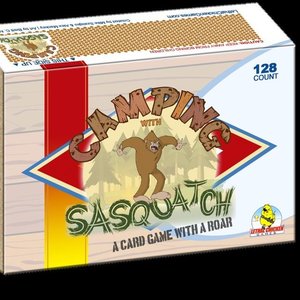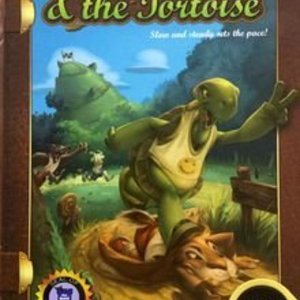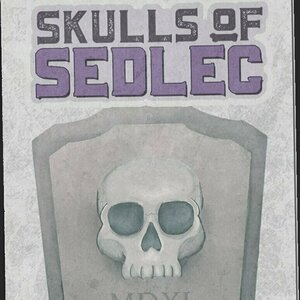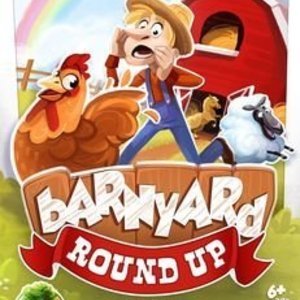Purple Phoenix Games (2266 KP) rated SAIBOU in Tabletop Games
Aug 29, 2019
SAIBOU is “a little game of cells” and that tagline is just short of perfect. I say just short because the word “cute” has been omitted. This game is stinkin CUUUTE!! “Saibou” is the Japanese word for “cell,” and in this game the players are racing to complete a culture of cells by building a 3×3 grid of chibi cell cards. Opponents will be attempting the same as well as infecting your culture with horrible hungry bacterias and viruses to eat up your cutie cells. Luckily you have defenses and cures you can apply to keep your little culture garden thriving.
DISCLAIMER: We were provided a review copy of this game for the purposes of this review. These are preview copy components, and I do not know if the final components will be similar or different, or if the Kickstarter campaign will alter or add anything through stretch goals. -T
Setting up SAIBOU is a snap. Shuffle the big deck of square cards and deal out five to each player. On your turn play a card. It could be a cell, migrate, bacteria, virus, cure, or macrophage card. Cell cards are what you are trying to build in your culture and is your method of victory. Each cell card (except the wild) has colored half-circles on the edges that need to match up with neighboring cards to be valid plays.
Can’t seem to draw the perfect card you need? Play a migrate card and switch out an opponent’s card with one of yours (even if it has a token on it). Get that wild from your opponent and plop it right into your culture and watch them squirm. Feeling especially aggressive? Play a bacteria or virus card, place the corresponding token on the cell you want to infect and watch the devastation! Bacteria cards are of a specific color, or colors, that will be placed on cells of matching color. Viruses, however, are not so picky – they will go after ANY cell. “So what? Who cares if I contracted a virus?” Well, your culture cares because at the end of each player’s turn a bacteria or virus will consume the cell upon which it rests and then move on to the next surrounding cell. Bacteria move to matching colors, and viruses move to whichever card they can.
So, you’ve been infected. What now? Well, all is not lost. In the deck are several cure cards that picture medicine pills that can cure your culture of all bacteria and viruses. Would you like to prevent this from happening in the future? Play the white macrophage (looks like a beefcake cloud with Ray-Bans (not a sponsor)) card and place a white disc on any cell you would like to protect. That cell can no longer be a target of attack. Play continues in this fashion until someone has built a 3×3 grid and won the game!
Components. Per my disclaimer this game is still in prototype so I can only comment on the components provided to us. Keep in mind they may (and probably will) change or improve during the Kickstarter campaign. The game is a deck of cards and some plastic tokens. The cards are great and feature simply wonderful art. I totally dig the chibi style for this game and it was an inspired choice. Just looking at those cute cells instantly makes you want to protect them and creates a connection that pains you to lose them to a virus. A+ on art from me. The tokens, in this prototype version, leave much to be desired. The colors don’t really match the cards, but I am hopeful that will be improved upon as a result of the campaign for retail release. This didn’t cause ANY issues during game play, but upon teaching the game I had to reiterate that the card is actually a YELLOW cell that matches the yellow token. Perhaps the token will end up being orange to match the card because I think switching the card to yellow may cause issues when matching the colored edges. Unfortunately, that said, the colored discs on the edges of the cards (and also the corresponding tokens) do not really work with colorblindness, as there is no distinction other than color for these components. This may (and hopefully will) be considered for the final draft of the game. Luckily I do not suffer from colorblindness so I quite enjoy it all, but I need to be an advocate for those who do.
All in all this is such a lovely game that I am so happy we were able to play. The cute art and double-thinking adds so much to the game play that we just were eating up every time. Speaking of eating up, those bacteria and viruses are such powerful little bugs that can really muck up the best laid plans and create havoc on the table. It’s delicious! Note: we did not taste the game, so claims of deliciousness are for flavor only. Note 2: I guess I cannot use language without using words to describe food, even though this is not a game about food – but I would probably eat it because it looks so dang good. All this said, Purple Phoenix Games is super impressed by such a simple game, and we highly highly recommend any gamer type to check it out.
Purple Phoenix Games (2266 KP) rated Camping with Sasquatch in Tabletop Games
Jun 18, 2019 (Updated Jun 25, 2019)
Camping with Sasquatch is a super silly set collection, hand management, card shedding game in the party game genre featuring, well, Bigfoot. You are dealt a hand of cards of various suits (s’mores, hiking, fishy fishy, etc) and from the large draw pile of remaining cards are revealed three cards. On your turn you must draw a card from the draw pile, and play two cards from your hand. You score points by adding cards to the revealed cards on the table to make sets of suits Rummy style. So you can have a set of 3 like-cards, or a run(?) of 3 different cards, with Sasquatch cards in the same suit being wild. When you complete a set of cards on the table, you claim the set and put the cards in your scoring pile. Each card in your scoring pile is worth one victory point. The first player to shed his hand to zero triggers the end game, and the player with the most victory points is the winner. Duh.
Here’s what makes this game a little different and a little more interesting. The Sasquatch cards are wild. They can be used in a set or a run. Easy. However, you can play a Sasquatch card by itself to the table by slapping it down and calling out what suit it is: “Sasquatch Swimming!” When someone does that the other players must frantically slap the Sasquatch with an appropriate suit-matching card from their hand. If they cannot or if they are the last to do so they are awarded with all the cards that had just been played. In a shedding game, adding cards to your hand is always no bueno. This, however, leads to hilarity at the table, but also frustration if you play with bad sports, or uninterested opponents.
Components. This is a card game. The cards are of good quality, and the art is campy and cartoony. I quite like the art style, but some people I played with had mixed opinions on it. What I did appreciate was the one page folded rulesheet with full color Sasquatch poster on the back. I like light games with non-confusing rules. However, on that subject, I couldn’t find anywhere that it stated we could use more than the three slots to play our cards to next to the draw pile, even though there is a graphic that shows more slots in a dashed outline. We initially played the game with just the three slots available and it was a drag, man. Once we allowed some interpretation of the rules to open up more card slots, the game flowed quite a bit more easily and we enjoyed it much more.
Overall, this is just a silly game of shedding with a unique theme that we all liked. The Sasquatch slap aspect of the game gave it a nice little bump in interest for us, but ultimately we agreed that it was light and fun, but not one we will think to bring out very often. I would like to recommend this, but I will do so to a particular situational scenario. If you are ending your game night and just need a super light nightcap to help you tie one on, then pull out the ‘Squatch. He may eat your hot dogs, but he’s just trying to make a living too. Purple Phoenix Games gives this one a hairy 15 / 30.

Contract Killer: Sniper
Games and Entertainment
App
You are a master assassin, hired to infiltrate secure locations and eliminate high-profile targets....

Bangkok Grand Palace Audio Tour Guide
Travel and Navigation
App
This mobile app is the perfect guide for visitors to the Grand Palace in Bangkok, Thailand. It’s a...

DJ Rig for iPad
Music and Photo & Video
App
THE PRO-QUALITY DJ MIXING APP NEW VERSION INTRODUCES PLUG AND PLAY SUPPORT FOR iRIG PADS! DJ Rig...

DJ Rig FREE for iPad
Music and Photo & Video
App
NEW VERSION INTRODUCES PLUG AND PLAY SUPPORT FOR iRIG PADS! DJ Rig is a full-featured DJ mixing app...

Fireman Sam - Junior Cadet
Games and Education
App
OFFICIAL LICENSED FIREMAN SAM APP New FREE Update: Includes an 20 Extra Stickers and 4 Exciting New...
Purple Phoenix Games (2266 KP) rated Tales & Games: The Hare & the Tortoise in Tabletop Games
Mar 12, 2020
We all know the story of the Tortoise and the Hare, where quick but cocky Hare naps during the race while “Slow and steady wins the race” Tortoise passes him and ultimately does, in fact, win the race. From what I remember of this story, it was a race between the Hare and the Tortoise. However, in this little bookbox game our titular heroes are joined in the rematch race by Wolf, Lamb, and Fox. Who do you think will win this silly race? Place your bets!
DISCLAIMER: I do not intend to cover every single rule included in the rule book, but will describe the overall game flow and major rule set so that our readers may get a sense of how the game plays. For more in depth rules, you may purchase a copy from the publisher directly or from your FLGS. – T
The winner of Tales & Games: The Hare & The Tortoise (which I will try not to write again) is the player who can get their favored characters across the finish line first. This is accomplished throughout the game by players throwing cards on their turn to help characters jockey for position. Each character has a special ability to help them achieve victory, and utilizing these abilities at just the right time could mean the difference between the podium or the port-a-potty.
To setup, build the race track using the provided tiles in any fashion you prefer. Place the Start tile, the Finish Line, and the winner’s podium in their places, set out the character animeeples, and deal each player a secret betting card (with the starball on the back). These cards will dictate who you want to win the race. Deal each player seven cards from the checker board backed deck, and have each player choose one of the dealt animals as their secondary choice for the race. You are now ready to play.
On a player’s turn they will play any 1-4 cards they want provided the set of cards played feature the same animal. This will continue around the table until eight animal cards have been played, OR four of the same animal. At that point, the animals will move and activate any special abilities. These abilities vary by animal, and I won’t be listing out each ability, but each animal can move differently depending on how many cards of each animal are played. Play continues in this fashion until three animals have crossed the finish line and claimed their spots atop the podium. Each spot on the podium scores appropriately (5 VP for 1st, 3 VP for 2nd, 2 VP for 3rd place), and the players who own betting cards of the winning animals total their points for the game and a winner is decided.
Components. This is one of the IELLO Tales & Games series that are presented in a nice little book-shaped magnetic box. The box is cool, the insert is… serviceable, and the cardboard components are great. The cards are good, and the animeeples are cute. So overall IELLO gets two claws up from me.
I do not have many betting games that I actually enjoy, so having this little nugget of joy on my shelves feels good. When my children are old enough to really get into gaming, I feel confident that I can pull this out, read the included fable, and play the game with them easily. You’re just throwing cards trying to get your preferred animals to win a race. It’s a great, easy, fun little game that has always gone over well each time I have pulled it out. It will never join my Top 10 Games Ever list, but it is definitely an Old Faithful game that I will have available to whomever would like to play. If you like light racing and betting games with cute themes, then you need to play this one. Purple Phoenix Games gives this a carbo-loaded 9 / 12.
Purple Phoenix Games (2266 KP) rated Skulls of Sedlec in Tabletop Games
Feb 27, 2020
Let us travel back to the 16th Century AD. You are a monk working in the Sedlec Ossuary, a chapel in the Czech Republic. The coincidental timing of the Black Plague and the Hussite Wars has led to some serious overcrowding in the Sedlec graveyard. Working under a half-blind monk, you and your fellow underlings have been tasked with exhuming graves and artfully arranging the skulls in the crypt. Who can create the most unique and tasteful display of skulls? There’s only one way to find out.
Disclaimer: We were provided a prototype review copy of this game for the purposes of this preview. The final components may vary once the Kickstarter campaign has concluded, so the published game may look differently than the one presented in these pictures. -L
Skulls of Sedlec is a game of card drafting and hand management in which players are trying to amass the most points by the end of the game. Here’s how it works. To set up, shuffle all 18 cards. Create a 2×3 grid of 6 facedown piles consisting of 3 cards each. Pick any pile and flip one card face-up from the top. You are now ready to begin! The game is played over a series of turns in which players will draft and play cards into their personal Stack, an arrangement of cards in a pyramid shape. Each card has 2 skulls on it, and each skull earns a certain number of points based on its placement in your Stack. For example, Criminal skulls are vying for redemption in the afterlife, so they score 2 points if they are adjacent to any Priest skulls. At the end of the game, the player with the highest scoring Stack is the winner!
During the game, on your turn, you will take one of these three possible actions: Dig, Collect, or Stack. When you choose to Dig, you choose 2 facedown piles in the graveyard and flip their top cards face-up. Once you have done that, choose one of the two cards you flipped to take into your hand. If you choose to Collect, you simply choose any face-up card from the graveyard and take it into your hand. There is a hand limit of 2 cards per player, though, so if you already have 2 cards in your hand you may not take the Collect action. If you choose to Stack, you select one card from your hand and add it to your Stack, following the placement rules – Stacks are built from the bottom up. Your first card will be placed into the bottom row of your Stack. Depending on how many players are in the game, your Stack will require a different number of cards in each row. A card may only be played into a higher row if it is directly centered over two cards on the row beneath it. Logical enough! The game ends when each player has completed their Stack. Points are then added, and the highest score wins.
As I mentioned earlier, the size of the game does not always dictate the quality of the game, and Skulls of Sedlec is the perfect example of that. For only consisting of 18 cards, it takes a good deal of strategy to claim victory. There are 5 different types of skulls, and they earn points in different ways depending on their placement. You really have to be thinking in advance as to how you want to play the cards in your hand, and what other skulls you need to pick up to maximize your score. You can also see the Stacks of your opponents, so you know what you’re up against. You need an adaptive strategy for success based on the current cards available in the graveyard, as well as potentially anticipating your opponents’ moves. Be careful, though, because once a card has been played to your Stack, it cannot be moved.
Components. Again, this is just a preview copy of the game, but the card quality is already great. It might be something upgraded during the Kickstarter campaign, but if it’s not, you’re still getting a high quality game. Of course, the trademark wallet is on par with the rest of the wallet series, and it protects the cards well. The artwork of Skulls of Sedlec might not be awe-inspiring, but it is still colorful, thematic, and well-done. I appreciate the simplicity of the cards because it makes it easier to see the card types throughout the game and final scoring. You can clearly tell which skulls are which, so the game does not grind to a halt while trying to figure out what the scoring requirements are for a particular skull. And each skull type has a corresponding symbol, which can help our color-blind friends play the game – instead of relying solely on color, the symbols help differentiate the cards. So big kudos there!
As someone who does a fair amount of solo playing, I would like to mention the solo expansion of Skulls of Sedlec, Monstrance. Again, this is a preview of the solo expansion, so final rules and components may vary from those described here. When playing Skulls of Sedlec as a solo game, you will be creating a Stack like in a multiplayer game, as well as a Feature. The Feature you build will have a shape different to that of your normal Stack, and is determined by the Feature card you select at game setup. You will also select a second Feature card, which will be flipped over to reveal a new condition or effect for the game (for example, Romantics in the Stack do not score). Create a graveyard of 4 facedown piles of cards, evenly spread throughout the piles. You are then ready to play.
Gameplay is similar to that of a multiplayer game, but the solo player does not have a hand of cards. Instead, every card that you select will be immediately played into your Stack or your Feature. Placement rules are the same for the Stack, and cards in your Feature must be supported from below or adjacently. When both your Stack and Feature are complete, the game is over and you tally up your score. The solo expansion offers scoring milestones to compare with your score. See if you can best yourself and become a Legendary Artisan instead of remaining a Humble Monk.
Personally, I am not a huge fan of beat-your-own-score solo expansions. That being said, the gameplay of the Monstrance solo expansion still requires decent strategy and thought to maximize your final score. The addition of Features to solo play add another level of strategy because placement is just as important there as it is in your general Stack. Another neat twist is the addition of effects/conditions in solo play. They affect your strategy and make for a unique game every play.
Overall, I would say that Skulls of Sedlec is one of my favorite ButtonShy Games that I have played. It’s fast to play, simple to teach and learn, yet strategic enough that it keeps you engaged the entire time. Another thing I love about it is that it is only a 2-3 player game. We all know that getting together for game nights can be tricky, so I can see myself bringing Skulls of Sedlec to many game nights in which maybe only a few of us could attend. I’m glad I got the opportunity to preview this game, and I will be following the progress of the campaign for sure. If you’re looking for a small filler that still keeps your brain working, definitely consider backing the Skulls of Sedlec campaign!
Purple Phoenix Games (2266 KP) rated Barnyard Roundup in Tabletop Games
Apr 12, 2021
Barnyard Roundup is a silly game of bluffing and hand management set on a farm. In it players are farmhands trying to help Farmer Brown sell the most animals at market. They do this by bluffing their hands in trade deals with other farmhands, thus making no friends in the process. The player with the most points at the end of the game, when all cards from the draw deck have been drawn, will be the winner!
DISCLAIMER: We were provided a copy of this game for the purposes of this review. This is a retail copy of the game, so what you see in these photos is exactly what would be received in your box. I do not intend to cover every single rule included in the rulebook, but will describe the overall game flow and major rule set so that our readers may get a sense of how the game plays. For more in depth rules, you may purchase a copy online or from your FLGS. -T
To setup place the five Animal Bonus cards in a line with the Set Bonus cards nearby. Shuffle the large deck of animal cards and deal out cards according to the rulebook per the number of players in the game. The Burglar and Excuse Me tokens are sorted and dealt out with the remainders face-down near the other cards. Remove eight cards from the draw deck and decide who will be the start player. The game may now begin!
Barnyard Roundup turns are quite simple: take two or three actions and end the turn. The first action is mandatory and it is Passing Cards to another player. Choose anywhere from one to six cards, place them face-down on the table in front of the player with whom to be traded, and announce the number and type of cards to be traded. For example, a player may say, “This is four chickens.” The targeted player now must decide whether that group actually IS a group of four chickens or if they believe the trader (not traitor) is bluffing. If so the targeted player may say, “That is NOT four chickens.” Once the agree/disagree statement has been made the cards are flipped over to see which player will be adding the cards to their pens. If the targeted player guessed correctly then they will received all the animal cards that were passed to them. That is, unless the cards were actually CROWS. Crows are worth -5 VP at the end of the game (see the photo below) and will be taken into the pen of the defeated player in the trade. In addition to crows (bad) the game includes Copy Cats (good) which can be wild cards to be placed with other animals and they copy the animal in their group. When the trade is resolved the active player may choose to perform the next step, but it is not mandatory.
Players must note that any time a player gains crows that would extend their collection of crows to any multiple of 3 that player must then draw another Action Token (Burglar, Excuse Me, Scarecrow) from the supply. If a Scarecrow is drawn it is immediately revealed and three crows are discarded from that player’s collection. The Excuse Me token may be used during a trade, but before cards are revealed, by a player not involved in the trade. When they announce, “Excuse Me,” they immediately take the place of the targeted player and will decide whether the trade is correct as announced or is a bluff.
Should they wish, the active player may now Play a Burglar Token from their collection in order to target another player and ask for all of their animals of a specific type – “I wish to procure all of your cows” That player must then immediately hand over all their cows, or else may tell the active player to Go Fish. Okay, that last part isn’t in the rules, but I started doing it and it stuck for me.
The third and final step of a turn is simply to Draw Cards and End Your Turn. Draw cards back up to the hand limit of 5 or 6 and end the turn. Play then passes to the next player.
Play continues in this fashion until the last card has been drawn. The game ends immediately and players tally their points per the rulebook to arrive at an ultimate winner!
Components. This game is a bunch of cards and some tokens in a double-wide+ tuckbox. I love the art, and that makes sense as it is illustrated by Lina Cossette, half of Mr. Cuddington. If you don’t know about Mr. Cuddington, please check out their website. The cards are good quality, as are the tokens. But that box. Now, it LOOKS great, and is a fine size. But a tuckbox? I would have preferred a lidded box, or even one of those with the magnetic fold-out lids. But it’s a tuckbox and the opening flap dented upon its first opening. Oy. I could give a chef’s kiss to everything else though.
Now, there’s a reason why I rated this game a 4 and my wife a 6: she beats me every single time we play and I just cannot find the strategy to take her down. Am I just horrible at bluffing games? Does she just dominate me at ALL games? I’m not sure, but this one certainly highlights the fact that she’s just better than me. I can still hear her haunting and taunting me with, “OH MY GOSH I LOVE THIS GAME! I’M SOOOOO GOOD AT IT!” Meanwhile I am sitting pretty with a whole flock of crows laughing at me like I am the Scarecrow from Wizard of Oz. Perhaps I am truly brainless as well.
That said, the game is enjoyable. I do like to play bluffing games, but I’m the poor soul who would rather play straight than do ANY sort of bluffing at all. Except when I have lulled my prey into trusting my every declaration. Then pull out the big guns and laugh my way to the bank. Well, I tried that several times and no dice. But I do enjoy playing, and I do keep coming back for more torture. And if that isn’t a sign of a good game, then what is?
All in all the game is quick, light on rules, and features wonderful art style. This is the game I will probably use to introduce my children (or new gamers) to bluffing games as the theme is easily digestible and when you get stuck with the negative points you don’t feel super bad about it. It is easy to pronounce that Purple Phoenix Games gives this one a squawkin’-good 10 / 12. If you are looking for a light introductory game to teach bluffing or to hit that sweet-spot, then I recommend you check out Barnyard Roundup from Druid City Games. I ain’t a-bluffin’ ya.




